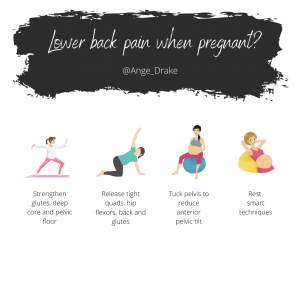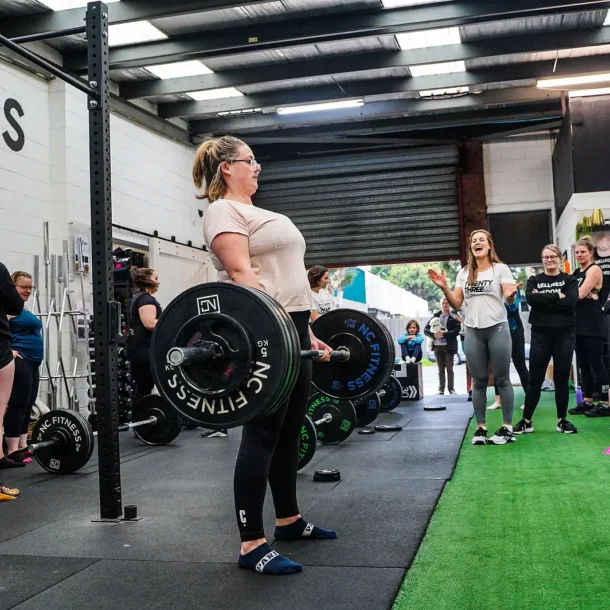

Lower back pain is one of the most common complaints during pregnancy in over 72% of all expectant mothers. As your body changes to accommodate your growing bub there are new stresses placed on the pelvis and lower back. The back may become sore or inflamed for a variety of reasons. This could be due to:
The good news is that you can take steps to take the pressure off the lower back by using movement. Of course heat or cold packs, swimming, a warm bath, massage, musculoskeletal treatments, using a pregnancy pillow and compression garments might all help too, but in this article I really want to explore how movement can help specifically.
How should I exercise when pregnant?
Let’s address this big question first. Exercise for pregnant women has a huge list of benefits. This includes improved mental, physical and emotional health, reduced risk of excessive weight gain, reduced aches and pains, it may make delivery easier and assist in a faster recovery. Despite more women championing exercise, there is still some confusion about what types of exercise is ‘best’ when pregnant. The simple answer? Continue doing what you were doing before pregnancy unless it starts to cause pain, you are considered ‘high risk’, your doctor has told you to limit your exercise, it involves high impact, contact or is highly vigorous.
Ensure that you avoid any exercises or loads that cause discomfort in your lower back. Remembering that what works for one pregnant body might not work for another.
Listen to your body and modify
You can modify any exercise you’ve been doing to fit you as your belly grows. The most important thing is to listen to your body. Stop if you are feeling overly fatigued, out of breath or sense any pain. Now is not the time to be jumping into a new exercise regime, but you could start with some gentle stretches, body weight exercises and walking. We recommend that if you are experiencing any musculoskeletal issues that you seek the guidance of a qualified healthcare provider, like an osteopath or physiotherapist, to have it properly diagnosed and an appropriate course of action put in place.
We highly recommend Inner North Physiotherapy group in Thornbury, who are highly skilled in treating pregnancy related pelvic floor, Diastasis Recti and other musculoskeletal concerns.
Reducing back pain
Back pain during pregnancy can reduce through movement. This could be by stretching, strengthening and/or developing better postural awareness.
Incorporating a stretching routine into you day or week is a great way to take the pressure off the back by stretching the quadriceps, hip flexors, lower back and gluteals. Stretching will help keep the body in good alignment. Some great stretches we recommend include: pelvic tilting (sitting or a Swiss ball), hip circles, thread the needle, cat/cow stretch, mermaid stretch, knee rolling (see the Pilates session below), pec stretches, seated piriformis stretch and kneeling or standing hip flexor stretch.
Exercises that strengthen the T-Zone, pelvic floor or gluteals will help to add stability to the hips and ensure the posterior muscles are working well to ease pressure on the back. This is why we love prenatal Pilates workouts as you can specifically target the glutes, T-Zone and pelvic floor in a variety of pregnancy safe positions.
The team at 23W regularly produces prenatal specific mat based Pilates workouts you can do at home. Check out this Back Pain specific Pilates session with Ange.
As the baby grows in utero, we see an increase in the natural curve of the lower back. This in itself might not cause pain. Studies show there is no link between increased lumbar lordosis in pregnancy and the incidence of pain. However, it is important to be aware of posture and alignment changes as this will affect breathing, walking and optional movement. If you are experiencing back pain when standing, consider tucking the pelvis under slightly to see if the pressure eases. This can be done when walking, standing, sitting or exercising.

A final word on pregnancy aches and pains
While it is common to feel aches, pain and discomfort while pregnant, don’t suffer in silence. Take steps to seek professional help to manage and treat the cause.
For more information on how to navigate pregnancy safely, head to another great article: So You Are Pregnant: How to Navigate Exercise Safely.

Ange Drake is an personal trainer, women’s empowerment coach and fitness blogger in the northern suburbs of Melbourne. She is the director of one of the few womens’ only strength training gyms in Melbourne, 23W. Ange helps women to learn how to use strength based training, nutritional strategies and a positive mindset to transform their bodies, relationship with food and mind.
Can’t decide which of our packages is best suited for you? Take our questionnaire to help you decide!





